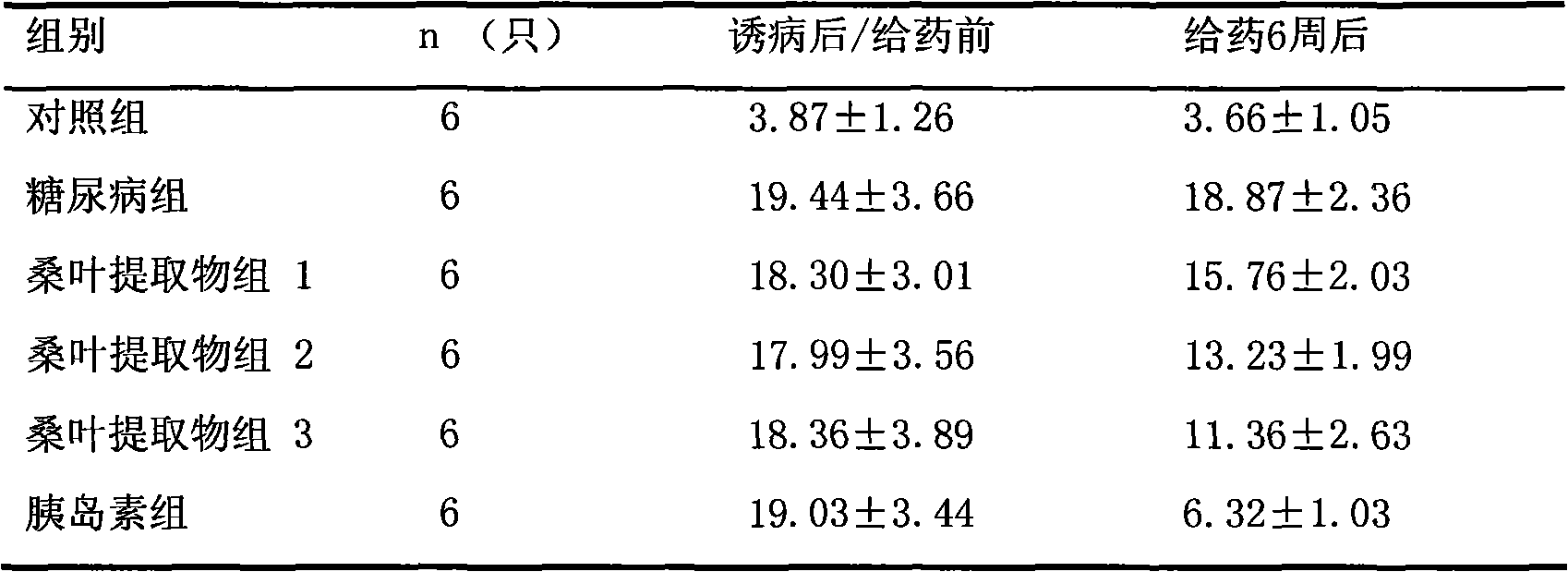Application of polysaccharide from mulberry leaves in preventing and treating diabetes
A technology of mulberry leaf polysaccharide and diabetes, which is applied in the field of natural medicine application, to achieve the effect of simplifying the production process, reducing production cost, and small side effects
- Summary
- Abstract
- Description
- Claims
- Application Information
AI Technical Summary
Problems solved by technology
Method used
Image
Examples
Embodiment 1
[0014] Embodiment 1: the preparation method of mulberry leaf polysaccharide
[0015] Crush and dry 10kg of mulberry leaves, add 180L of distilled water, heat and reflux at 70°C for 90 minutes, filter twice with three layers of gauze, then filter with a ceramic membrane, concentrate under reduced pressure to 10L, then deproteinize the concentrated solution with 10% trichloroacetic acid, and put it on SEPHADEX G-10 column separation and collection of mulberry leaf polysaccharide fractions, concentration to 1 L, separation and collection of mulberry leaf polysaccharide fractions on a silica gel column, concentration to dryness to obtain mulberry leaf polysaccharides. As determined by the anthrone-concentrated sulfuric acid method, the polysaccharide content of mulberry leaves is 95.5%.
Embodiment 2
[0016] Embodiment 2: Mouse feeding experiment of mulberry leaf polysaccharide
[0017] 1. Diabetic mouse model
[0018] (1) Adult Kunming mice (20-25g) were bred under ventilated conditions (25±1°C), with 12 hours of light and 12 hours of darkness, ad libitum, and standard feeding.
[0019] (2) Induction of diabetic rats: In accordance with the requirement of 45 mg / kg, streptozotocin (dissolved in 0.1M citric acid buffer pH 4.5) was injected intraperitoneally. For 7 consecutive days, blood was collected from the tails of fasting mice, and mice with a fasting blood glucose of 200 mg / dl were selected as experimental subjects. 2. Experimental design:
[0020] 2. Divide the experimental mice into 6 groups, 6 in each group: measure the fasting blood glucose before the experiment
[0021] Group 1: normal non-diabetic rats, drinking distilled water;
[0022] Group 2: Diabetic mice, distilled water;
[0023] Group 3-5: Diabetic rats were given mulberry leaf extract 0.25, 0.5, 1.0...
PUM
 Login to View More
Login to View More Abstract
Description
Claims
Application Information
 Login to View More
Login to View More - R&D
- Intellectual Property
- Life Sciences
- Materials
- Tech Scout
- Unparalleled Data Quality
- Higher Quality Content
- 60% Fewer Hallucinations
Browse by: Latest US Patents, China's latest patents, Technical Efficacy Thesaurus, Application Domain, Technology Topic, Popular Technical Reports.
© 2025 PatSnap. All rights reserved.Legal|Privacy policy|Modern Slavery Act Transparency Statement|Sitemap|About US| Contact US: help@patsnap.com



